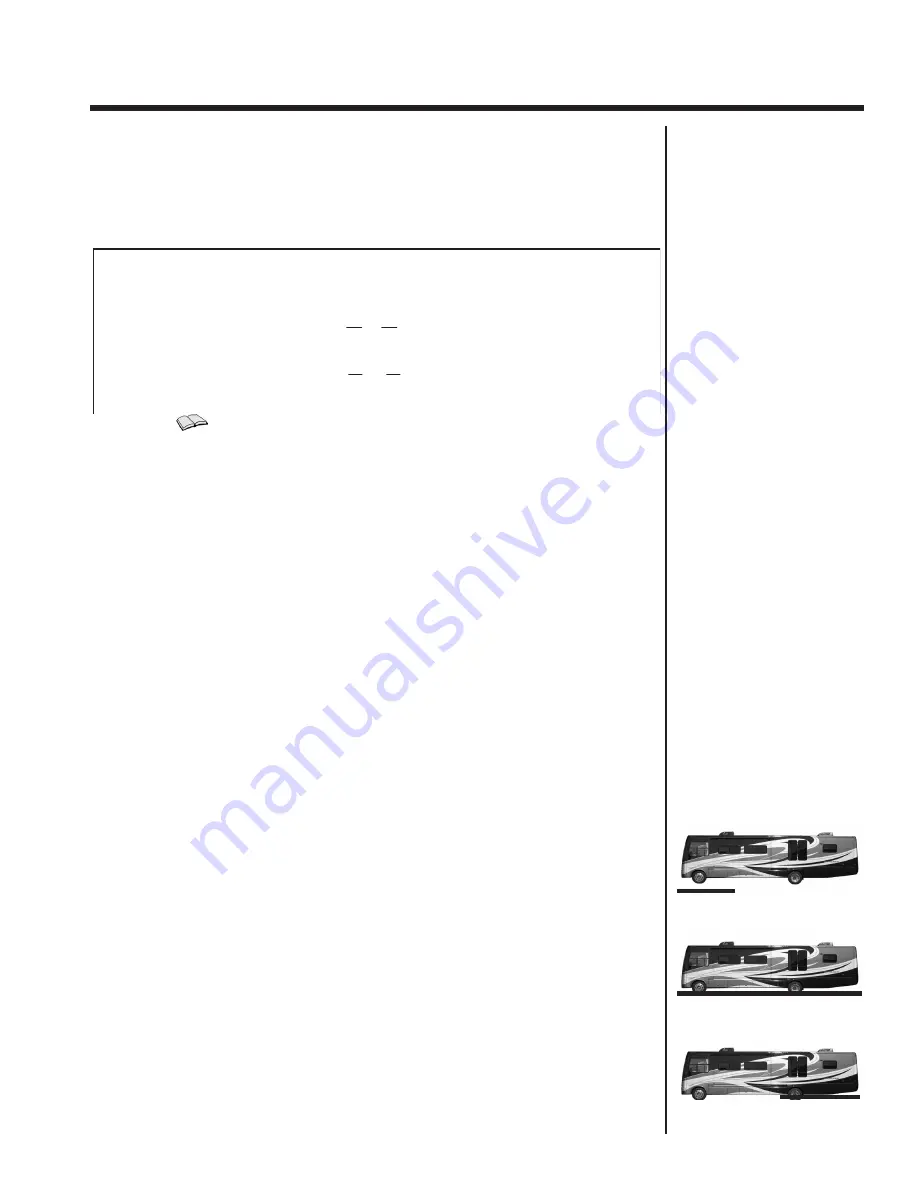
21
The total weight of passengers, cargo, trailer tongue weight, and water should never
exceed the value shown on the label.
A typical example of this label is shown below for reference purposes only. The
numbers shown on this page may not be applicable to your vehicle. Please reference
the Yellow label affixed directly to the door of your motorhome for your actual Occupant
and Cargo Carrying Capacity:
Note:
DO NOT OVERLOAD THE Motorhome
When loading your cargo, be sure it is distributed evenly to prevent overloading front
to back and side to side. Heavy items should be placed low and as close to the axle
positions as reasonable. Too many items on one side may overload a tire.
Periodically weigh the motorhome at a public scale to determine axle loads. The
following procedure is suggested, although any method recommended by the
scale operator which correctly determines weight value is acceptable. During all
measurements, it is important to keep the vehicle as level as possible.
To weigh your motorhome correctly, measure the fully loaded vehicle axle by axle
and wheel position by wheel position. You can find several certified public or com-
mercial scales at moving and storage lots, farm suppliers with grain elevators, gravel
pits, recycling companies and large commercial truck stops. You can also look in
the telephone book under “weighers” or “weighing”. Allow adequate time, since the
entire weighing process can take up to 30 minutes. There may be a small fee for
each weight taken, but the expense is a worth while investment toward the safe and
economical operation of your motorhome.
Your motorhome must be weighed fully loaded. That is with passengers, food, cloth-
ing, fuel, water, propane, supplies etc. Any towed vehicle (car/pickup, boat, or
trailer ) or item loaded on brackets on the back of the motorhome should also be
included in the weighing.
1. The following steps are suggested when using a long platform scale:
a. Pull onto the scale so that only the front axle is on the
platform with the end of the scale midway between the front
and rear axles and record the scaled weight.
b. Pull forward until the full unit is on the scale and record the
weight.
c. Pull forward so that only the rear axle is on the scale and
record the weight.
Planning and Preparation
MOTOR HOME OCCUPANT AND CARGO CARRYING CAPACITY
VIN: # # # # # # # # # # # # # # # # #
THE COMBINED WEIGHT OF OCCUPANTS AND CARGO SHOULD NEVER EXCEED:
XXX kg or XXX lbs
SAFETY BELT EQUIPPED SEATING CAPACITY: XXX
CAUTION:
A FULL LOAD OF WATER EQUALS XXX kg OR XXX lbs OF CARGO @ 1kg/L (8.3 lb/gal)
AND THE TONGUE WEIGHT OF A TOWED TRAILER COUNTS AS CARGO
WEIGHING
YOUR LOADED
MOTORHOME
Where To Weigh Your
Motorhome
How To Weigh Your
Motorhome
Reading a
Reading b
Reading c
Summary of Contents for Palazzo 2015
Page 1: ......
Page 3: ...This page intentionally left blank...
Page 17: ...16 Warranty...
Page 25: ...24...
Page 37: ...36...
Page 41: ...40 Chassis...
Page 45: ...44...
Page 52: ...51...
Page 54: ...53 Controls and Operations Turn on power Retracting the jacks Press auto level touch pad...
Page 56: ...55 Controls and Operations Hydraulic Pump Function Wiring...
Page 75: ...74...
Page 76: ...75...
Page 77: ...76...
Page 78: ...77...
Page 79: ...78...
Page 87: ...86 Heating and Air Conditioning...
Page 105: ...104...
Page 133: ...132...
Page 138: ...137...
Page 141: ...140 Date Service Preformed Mileage Date Service Preformed Mileage Maintenance Schedule...
Page 142: ...141 Maintenance Schedule Date Service Preformed Mileage Date Service Preformed Mileage...
Page 145: ...144 Notes...
Page 146: ...145 Notes...
Page 150: ......













































